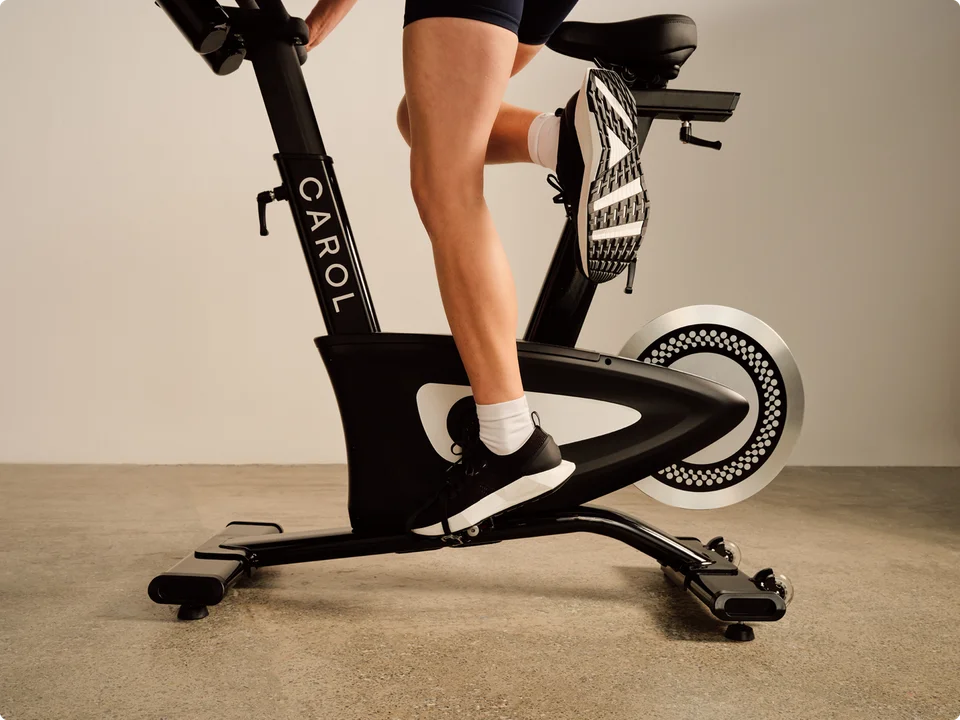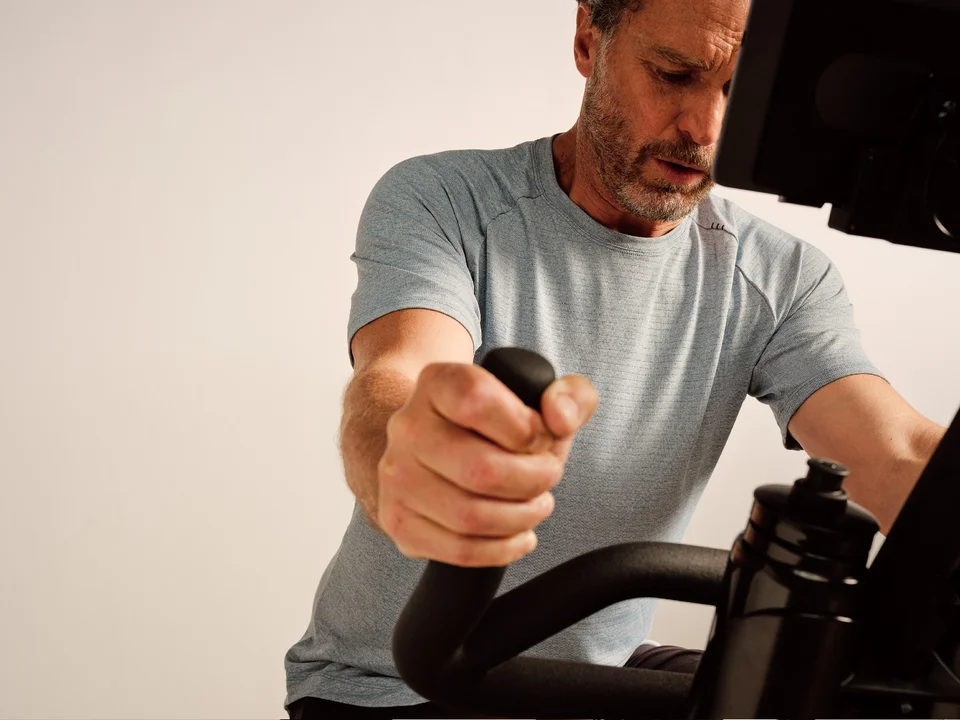Visceral fat, also known as ‘hidden’ fat, wraps around abdominal organs and can increase the risk of many diseases, including Alzheimer’s, type 2 diabetes, and stroke. The key to losing it is to adopt healthier habits gradually over time.
1. Do moderate aerobic exercise every day
While diet restrictions are often prioritized for weight management, aerobic exercise is an effective fat-burner. While the anaerobic system uses glycogen to produce energy, the aerobic system uses both glycogen and fat. During 10-month research on the impact of aerobic training alone on weight loss, participants lost up to 5.7% of their body weight by performing 400 or 600 kcal/sessions 5 days per week, compared to the control group that didn’t exercise.
The U.S. Department of Health and Human Services recommends having at least 150 minutes of moderate aerobic activity a week to keep your body weight in a healthy range. You can do this by including jogging, cycling, or swimming sessions in your weekly routine.
2. Add high-intensity sessions to your training
High-intensity training alternates brief high-intensity exercise with recovery periods. Such training enhances fat oxidation in your body leading to more efficient results compared to regular training. During a 15-week research program, young women who performed high-intensity interval exercise 3x per week demonstrated significant reductions in total body fat, particularly visceral fat, and insulin resistance.
Reduced Exertion HIIT (REHIT), developed by scientists looking for the shortest, most effective way to exercise, packs the benefits of high-intensity training into an even shorter workout. CAROL Bike’s 5-minute signature REHIT workout is designed to make you work at maximum capacity with only 2×20-second sprints followed up with recovery and cool-down periods. As a result, your body enters fight or flight mode and burns significantly more body fat. The results of an 8-week study showed that REHIT elicited more potent, time-efficient improvements in visceral fat loss when compared to traditional training.
3. Include strength training in your routine
According to studies, a combination of aerobic and resistance training causes greater belly fat loss and cortisol level improvements than aerobic exercise alone. Strength training improves your endurance during an aerobic workout. Larger muscle mass also increases your resting metabolic rate allowing you to burn more calories throughout the next 24 hours after the training. Adding 1 strength training session per week on top of your other exercise activities will help you maintain a healthy visceral fat ratio in your body.
4. Keep moving
Even if you do enough exercise, adding more physical activity to your daily life is beneficial for your health. You can walk more every time you have such an opportunity, use stairs instead of an elevator, use a standing desk at work, and park at the far end of the parking lot. Try to find smaller tricks like this in your daily routine to accelerate your metabolism.

REHIT on CAROL Bike is scientifically proven to deliver superior health and fitness benefits compared to traditional exercise—in 90% less time.

According to studies, a combination of aerobic and resistance training causes greater belly fat loss than aerobic exercise alone.
5. Limit sugar and simple carbs
Refined carbs, sugar, and starches are quickly converted into glucose, leading to a sudden spike in energy and blood sugar levels. However, this is quickly followed by a crash of fatigue and hunger as the glucose is depleted, resulting in increased food cravings and calorie intake.
In order to fight belly fat it’s important to keep your blood sugar stable and rely on more long-term sources of energy such as complex carbs and unsaturated fats. A 2020 study confirmed that a low carbohydrate diet is beneficial for losing visceral fat in older populations. On top of that, a low-carb diet lowers your insulin level, an excess of which can prevent you from losing fat.
6. Opt for healthy fats
Rather than adopting a low-fat diet, it’s more beneficial to opt for “good” fats and avoid harmful “bad” fats.
Unsaturated fats and omega-3 fatty acids are important for weight control. They provide a lasting stable source of energy and reduce the feeling of hunger for hours after. Healthy fats can be found in vegetable oils, nuts, and fish (also rich with omega-3.) A 2018 study concluded that a diet enriched with olive oil can be an important weight control strategy in people without cardiovascular disease. Studies in adults and children with fatty liver disease have shown that omega-3 supplements may significantly reduce liver and abdominal fat.
Saturated fats contained in red meat and dairy should be consumed in moderation since they can increase cholesterol level and the risk of cardiovascular disease. Trans fats created by pumping hydrogen into unsaturated fats should be avoided at all costs. Trans fat diet induced an increase of belly fat and changes in insulin sensitivity in monkeys, according to one study.
7. Eat more protein
If your goal is to lose belly fat, adding high-quality protein to your diet is one of the most effective changes you can make. Research shows that increasing your intake of protein can lead to less visceral fat. That’s because protein keeps you feeling full longer, reduces food cravings, boosts metabolism, and supports muscle recovery after exercise. To see visible results, aim for at least 25-30% of your daily meals to be rich in protein.
8. Increase healthy products in your diet
Certain types of products such as fiber, probiotics, and green tea have been shown to improve digestion and help get rid of belly fat faster.
Fiber widely found in vegetables, fruits, and wholegrain cereals contains very few calories, absorbs water, and moves through your digestive tract slowly, helping you feel full for longer. Fiber also improves digestion function. The effectiveness of adding more fiber to your diet for weight loss and dietary adherence was proven in a 2019 study.
Probiotics play a significant role in many body functions from the immune system to digestion to mental health. A review of 15 studies showed that people who took probiotics experienced significantly larger reductions in body fat percentage, and BMI compared with those who took a placebo.
A 2022 review of the effect of green tea demonstrated its positive impact on lowering blood glucose levels and reducing visceral fat.
An elliptical workout not only helps you to burn calories and lose weight, but it is also great for strengthening muscles and improving cardiovascular health. It engages both the lower and upper body muscles, providing a whole body workout.
9. Experiment with your meal schedule
There are different theories about the frequency of meal schedules. Some suggest having 6 smaller meals a day while others focus on the beneficial impact of fasting on weight management. You may need to consult your doctor and experiment with different schedules to find what suits your body the best.
Some studies suggest that frequent nutrition reduces food cravings and increases fat oxidation associated with belly fat loss. However, there’s no evidence that such a meal plan boosts metabolism. It can be psychologically more comfortable for some people.
A study of alternate-day fasting trials lasting 3-12 weeks showed that they significantly reduced body weight and body fat—for several reasons. Firstly, insulin naturally lowers during periods when you don’t eat which contributes to the fat-loss process. Secondly, a short eating window makes you skip at least 1 meal per day, which results in fewer calories consumed.

A study on alternate-day fasting showed a significant reduction in body weight and body fat.
10. Keep your calorie intake above 1,200
If you cut calories too much, your body enters starvation mode—a defense mechanism that lowers your metabolic rate to prevent excessive fat loss and starvation. This hinders your sought-after weight loss outcome. The lower bound of the low-calorie diet goes at 1,200 calories per day. Such a diet has proven to be efficient for sustainable weight loss but it is not recommended to decrease your calorie intake lower than that.
Reducing calories alone is not going to be the answer to lifelong success in maintaining a desirable weight. It’s best to combine it with regular physical activity and a healthy lifestyle in general.
11. Drink more water
Drinking water accelerates weight loss in a variety of ways. It suppresses your appetite, boosts your metabolism, and makes exercise easier and more efficient, all of which could contribute to results on the scale. Water is also a key chemical component of lipolysis—the process by which the body burns fat for energy. Lack of water visibly slows the fat-burning process, according to a 2018 study.
The U.S. National Academies of Sciences, Engineering, and Medicine determined a daily norm of 3.7 liters of water a day for men and 2.7 liters for women.
12. Cut down alcohol
Studies link alcohol consumption to a significantly increased risk of developing excess abdominal fat. Alcohol contributes to weight gain in many ways: it adds more empty calories to your daily calorie intake, increases your appetite, leads to unhealthy food choices, and is often combined with sugar in cocktails. On top of that, drinking overloads the liver—it won’t start processing the carbs and fats before it utilizes all ethanol. This means that most of the food you eat while drinking will be turned into belly fat.
You don’t have to refuse alcohol completely to get rid of excess belly fat. Research suggests that decreasing the frequency and intensity of drinking results in a significant decrease in visceral fat within a month.
13. Drink black coffee
Coffee contains plenty of healthy nutrients and antioxidants, improving your digestive health and supporting muscle function. Caffeine is known to boost metabolism, improve energy, and thus promote belly fat loss.
Caffeine increases your basal metabolic rate—the number of calories your body burns while resting. A 2018 study found that participants who drank coffee over the course of 2 months had greater metabolites, a product of metabolism.
If you want to use coffee as an effective means of reducing belly fat, you have to drink it black and avoid any supplements such as milk, cream, or syrups adding extra calories. It is also recommended not to exceed 4 cups per day to avoid potential side effects.
14. Eat more calcium and vitamin D-rich products
Individuals with increased body fat often have lower blood levels of vitamin D compared with lighter-weight persons. Recent evidence suggests that higher calcium and vitamin D intake may be associated with visceral fat loss and better metabolic health.
To increase calcium content in your body, eat more spinach, kale, okra, and white beans. Vitamin D-rich products include dairy products, soy milk, cereals, beef liver, and egg yolks. Fatty fish like salmon is a great source of both nutrients.

Recent evidence suggests that higher calcium and vitamin D intake may be associated with visceral fat loss and better metabolic health.
15. Quit smoking
In the short term, nicotine increases energy expenditure and reduces appetite, which may explain why smokers tend to have lower body weight. However, the long-term side effects of smoking are very damaging to overall health and maintaining a healthy weight. Smoking increases insulin resistance, the risk of metabolic syndrome and diabetes all of which are associated with weight gain. What makes it even worse, smoking tends to push all extra fat into the belly area.
In many cases, smoking is associated with a cluster of harmful habits such as lack of physical activity, poor diet, and alcohol drinking, so it can be hard to determine the impact of it alone. Quitting smoking is an important step on a way to a healthier lifestyle promoting normal body weight.
16. Get enough sleep
Sleep deprivation creates many health risks, including obesity. A systematic review of 36 publications showed that short sleep duration is strongly and consistently associated with concurrent and future obesity. Sleeping less than 7 hours at night increases levels of the hunger hormone ghrelin and decreases levels of leptin which makes us feel full. This causes sleep-deprived individuals to have a bigger appetite and to eat more, especially high-calorie foods.
Lack of energy after a short sleep also leads to reduced physical activity since people are less motivated to go to a gym or take a long walk.
To support long-term weight loss, try to get at least 7 hours of sleep per night.
17. Reduce your stress level
Stress triggers the production of the stress hormone cortisol which is associated with increased appetite and driving abdominal fat storage. This can create a vicious cycle as people who have more fat mass tend to produce more cortisol. Stress-relieving activities such as yoga, meditation, and breathing techniques reduce the cortisol level and improve sleep quality, facilitating weight loss in the long term.
A study of 92 overweight women during weight loss treatment confirmed a strong positive association between mental health improvements and belly fat loss.
18. Spend more time outdoors
Spending time in nature and natural light can benefit your weight loss process. Exercising outdoors burns up to 10% more calories than in a gym because the body has to adjust to the temperature, wind, and ground bumps. Fresh non-polluted air is rich in oxygen, and increased oxygen consumption, which triggers the fat-burning process. Exposure to the sun also increases your levels of vitamin D,which can impact belly fat loss.
19. Take days off
Revamping your lifestyle and consistently maintaining healthy habits is essential for long-term weight loss. While it may be challenging to stick to your new routine every day, taking occasional breaks can ease psychological pressure. Plan a few days off from your diet and exercise routine to recharge and avoid overtraining. Remember, there are no shortcuts to losing belly fat, and it requires a holistic approach to health.
To accelerate your weight loss journey, try CAROL Bike’s Fat Burn program.


